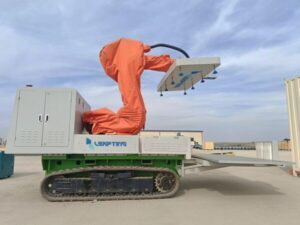The Chinese company Leapting is preparing to deploy in Australia its innovative photovoltaic module assembly robot, designed to automate the installation of large-scale solar panels. This system, powered by artificial intelligence, is capable of placing up to 60 panels per hour, resulting in a 30% reduction in installation costs and greater efficiency in the construction process.
Leapting’s first robot in Australia will be used in the construction of the Culcairn Solar Park, a 350 MW project in New South Wales, developed by the French company Neoen. Located on a land of approximately 1,000 hectares, this solar park is expected to be operational by 2026.
The robot, which will start operating this month, allows for complete automation of the installation process, minimizing the need for human intervention and significantly accelerating the plant’s construction.
Equipped with a crawler chassis and an automated navigation system with obstacle detection, the robot uses a robotic arm to pick up and place the panels on their supports. Its AI-based vision recognition system accurately identifies the position of the supports and adjusts the panel placement for precise fixing.
According to Leapting, manually installing a module typically requires between three and four workers and takes about 15 minutes. In contrast, their robot can complete this process in just one minute per panel, optimizing times and reducing labor risks.
 Photovoltaic module assembly robot. Photo: Social Media.[/caption>
Photovoltaic module assembly robot. Photo: Social Media.[/caption>
Automation and the future of the photovoltaic sector
In addition to the module assembly robot, Leapting has developed other automated solutions for the solar industry, such as panel cleaning and inspection robots. The company is confident that its technology will be particularly attractive to independent energy producers and engineering companies in Australia, where high labor costs make automation an efficient and cost-effective alternative.
The arrival of the robot in Australia is scheduled in the coming days, with a testing phase lasting approximately one week before its official launch in mid-February. With this advancement, Leapting aims to transform the solar energy sector, optimizing costs and accelerating the transition towards greater automation in large-scale projects.
Endangered deer monitored with robots in a National Park
Thanks to a project by the UNLP, deer are being surveyed in the Campos del Tuyú National Park using drones and advanced technology. Instead of traditional manual counting methods, drones equipped with automated monitoring systems are now being employed for this task. This change allows for more precise and efficient monitoring of the deer population in the park.
This database is essential for developing an algorithm that will enable automatic detection of these animals. This system not only facilitates the counting of individuals, but also allows for detailed tracking of herds, providing crucial information for the conservation of the species.
Have you visited our YouTube channel yet? Subscribe now!

